Kinetics of Microwave-Assisted Extraction Process Applied on Recovery of Peppermint Polyphenols: Experiments and Modeling
Abstract
1. Introduction
2. Results and Discussion
2.1. Extraction Kinetics
2.2. Mathematical Modeling
2.3. Chemical Profile of Volatile Compounds
| RT a | Compound | RIexp–RIlit | Identification | Content [mg/100 g] |
|---|---|---|---|---|
| 6.37 | Acetic acid ethyl ester | 615−609 c | RI, MS | 2.62 |
| 7.63 | 2-Methylbutanal | 660−664 c | RI, MS | 0.44 |
| 8.87 | Propanoic acid ethyl ester | 710−716 c | RI, MS | 0.50 |
| 9.85 | Isoamyl alcohol | 748−756 | RI, MS | 0.67 |
| 11.88 | Butanoic acid ethyl ester | 810−804 c | RI, MS | 0.75 |
| 15.09 | Styrene | - | MS | 2.75 |
| 15.21 | 2,5-Diethyltetrahydrofuran | - | MS | 0.21 |
| 15.27 | Nonane | 900−900 c | RI, MS | 6.94 |
| 16.18 | Tricyclene | 923−926 c | RI, MS | 0.35 |
| 16.51 | α-Pinene | 935−939 c | RI, MS | 0.55 |
| 16.72 | α-Fenchene | 949−952 c | RI, MS | 0.23 |
| 17.01 | (+)-Camphene | - | MS | 0.42 |
| 17.08 | Camphene | 958−954 c | RI, MS | 3.30 |
| 17.41 | Benzaldehyde | 969−960 c | RI, MS | 0.12 |
| 18.07 | p-Menth-3-ene | 985−987 c | RI, MS | 7.02 |
| 18.72 | α-Phellandrene | 1010−1002 c | RI, MS | 0.31 |
| 19.02 | α-Terpinene | 1018−1017 c | RI, MS | 4.98 |
| 19.24 | p-Cymene | 1025−1024 d | RI, MS | 11.36 |
| 19.38 | d,l-limonene | 1035−1029 d | RI, MS | 10.65 |
| 19.53 | 1,8-Cineole | 1035−1031 c | RI, MS | 13.52 |
| 19.71 | cis-Ocimene | 1046−1037 c | RI, MS | 0.15 |
| 20.16 | γ-Terpinene | 1069−1059 c | RI, MS | 6.05 |
| 20.94 | α-Terpinolene | 1090−1088 c | RI, MS | 3.59 |
| 21.05 | p-Cymenene | 1095−1091 d | RI, MS | 1.66 |
| 21.21 | 2-Methyl butyl 2-methyl butyrate | 1105−1100 c | RI, MS | 0.17 |
| 21.33 | Amyl isovalerate | - | MS | 0.49 |
| 22.86 | Menthone | 1148−1152 c | RI, MS | 16.74 |
| 23.11 | Isomenthone | 1160−1162 c | RI, MS | 7.88 |
| 23.18 | Menthene | - | MS | 0.45 |
| 23.26 | 5-Methyl-2-(1-methylethyl)-2-cyclohexen-1-one | - | MS | 0.47 |
| 23.36 | L-(-)-Menthol | 1175−1171 c | RI, MS | 3.96 |
| 25.90 | Menthomenthene | - | MS | 29.32 |
| 26.35 | 3,7,7-Trimethyl-bicyclo [4.1.0]heptane | 1295−1302 e | RI, MS | 0.59 |
| 28.11 | β-Bourbonene | 1381−1388 c | RI, MS | 0.23 |
| ∑TVC b | 150.70 | |||
3. Materials and Methods
3.1. Plant Material
3.2. Chemicals
3.3. Microwave-Assisted Extraction Protocol
3.4. Total Extraction Yield (Y)
3.5. Total Phenolic Content (TP)
3.6. Total Flavonoid Content (TF)
3.7. Mathematical Modeling
3.8. Gas Chromatography Mass Spectrometry (GC-MS) Analysis
3.9. Statistical Analysis
4. Conclusions
Author Contributions
Funding
Data Availability Statement
Acknowledgments
Conflicts of Interest
References
- Kumari, B.; Tiwari, B.K.; Hossain, M.B.; Brunton, N.P.; Rai, D.K. Recent advances on application of ultrasound and pulsed electric field technologies in the extraction of bioactives from agro-industrial by-products. Food Bioprocess Technol. 2017, 11, 223–241. [Google Scholar] [CrossRef]
- Dimić, I.; Teslić, N.; Putnik, P.; Kovačević, D.B.; Zeković, Z.; Šojić, B.; Mrkonjić, Ž.; Čolović, D.; Montesano, D.; Pavlić, B. Innovative and Conventional Valorizations of Grape Seeds from Winery By-Products as Sustainable Source of Lipophilic Antioxidants. Antioxidants 2020, 9, 568. [Google Scholar] [CrossRef] [PubMed]
- Azmir, J.; Zaidul, I.S.M.; Rahman, M.M.; Sharif, K.M.; Mohamed, A.; Sahena, F.; Jahurul, M.H.A.; Ghafoor, K.; Norulaini, N.A.N.; Omar, A.K.M. Techniques for extraction of bioactive compounds from plant materials: A review. J. Food Eng. 2013, 117, 426–436. [Google Scholar] [CrossRef]
- Heng, M.Y.; Tan, S.N.; Yong, J.W.H.; Ong, E.S. Emerging green technologies for the chemical standardization of botanicals and herbal preparations. TrAC Trends Anal. Chem. 2013, 50, 1–10. [Google Scholar] [CrossRef]
- Galanakis, C.M. Emerging technologies for the production of nutraceuticals from agricultural by-products: A viewpoint of opportunities and challenges. Food Bioprod. Process. 2013, 91, 575–579. [Google Scholar] [CrossRef]
- Milić, A.; Daničić, T.; Horecki, A.T.; Šumić, Z.; Teslić, N.; Kovačević, D.B.; Putnik, P.; Pavlić, B. Sustainable Extractions for Maximizing Content of Antioxidant Phytochemicals from Black and Red Currants. Foods 2022, 11, 325. [Google Scholar] [CrossRef] [PubMed]
- Mustafa, A.; Turner, C. Pressurized liquid extraction as a green approach in food and herbal plants extraction: A review. Anal. Chim. Acta 2011, 703, 8–18. [Google Scholar] [CrossRef]
- Chemat, F.; Vian, M.A.; Fabiano-Tixier, A.S.; Nutrizio, M.; Jambrak, A.R.; Munekata, P.E.; Lorenzo, J.M.; Barba, F.J.; Binello, A.; Cravotto, G. A review of sustainable and intensified techniques for extraction of food and natural products. Green Chem. 2020, 22, 2325–2353. [Google Scholar] [CrossRef]
- Kant, R.; Kumar, A. Review on essential oil extraction from aromatic and medicinal plants: Techniques, performance and economic analysis. Sustain. Chem. Pharm. 2022, 30, 100829. [Google Scholar] [CrossRef]
- Chan, C.-H.; Yusoff, R.; Ngoh, G.-C.; Kung, F.W.-L. Microwave-assisted extractions of active ingredients from plants. J. Chromatogr. A 2011, 1218, 6213–6225. [Google Scholar] [CrossRef]
- Périno-Issartier, S.; Zill-e-Huma; Abert-Vian, M.; Chemat, F. Solvent free microwave-assisted extraction of antioxidants from sea buckthorn (Hippophae rhamnoides) food by-products. Food Bioprocess Technol. 2010, 4, 1020–1028. [Google Scholar] [CrossRef]
- Zhang, H.-F.; Yang, X.-H.; Wang, Y. Microwave assisted extraction of secondary metabolites from plants: Current status and future directions. Trends Food Sci. Technol. 2011, 22, 672–688. [Google Scholar] [CrossRef]
- EDQM. Ph.Eur. 2013: European Pharmacopoeia, 7th ed.; Directorate for the Quality of Medicines and HealthCare of the Council of Europe (EDQM): Strasbourg, France, 2012. [Google Scholar]
- Gholamipourfard, K.; Salehi, M.; Banchio, E. Mentha piperita phytochemicals in agriculture, food industry and medicine: Features and applications. S. Afr. J. Bot. 2021, 141, 183–195. [Google Scholar] [CrossRef]
- Lv, J.; Huang, H.; Yu, L.; Whent, M.; Niu, Y.; Shi, H.; Wang, T.T.Y.; Luthria, D.; Charles, D.; Yu, L.L. Phenolic composition and nutraceutical properties of organic and conventional cinnamon and peppermint. Food Chem. 2012, 132, 1442–1450. [Google Scholar] [CrossRef] [PubMed]
- Riachi, L.G.; De Maria, C.A.B. Peppermint antioxidants revisited. Food Chem. 2015, 176, 72–81. [Google Scholar] [CrossRef]
- Commission, E. What Is Organic Farming?—Organic Farming. Available online: https://agriculture.ec.europa.eu/farming/organic-farming/organics-glance_en (accessed on 31 August 2019).
- Ikiz, M.; Demircan, V. Comparative Economic Analysis of Organic and Conventional Rose Oil (Rosa damascenae Mill.) Cultivation in Lakes Region, Turkey. J. Essent. Oil Bear. Plants 2013, 16, 352–363. [Google Scholar] [CrossRef]
- Dai, J.; Orsat, V.; Raghavan, G.S.V.; Yaylayan, V. Investigation of various factors for the extraction of peppermint (Mentha piperita L.) leaves. J. Food Eng. 2010, 96, 540–543. [Google Scholar] [CrossRef]
- Pavlić, B.; Teslić, N.; Zengin, G.; Đurović, S.; Rakić, D.; Cvetanović, A.; Gunes, A.K.; Zeković, Z. Antioxidant and enzyme-inhibitory activity of peppermint extracts and essential oils obtained by conventional and emerging extraction techniques. Food Chem. 2021, 338, 127724. [Google Scholar] [CrossRef]
- Routray, W.; Orsat, V. Microwave-Assisted Extraction of Flavonoids: A Review. Food Bioprocess Technol. 2011, 5, 409–424. [Google Scholar] [CrossRef]
- Moldovan, R.I.; Oprean, R.; Benedec, D.; Hanganu, D.; Duma, M.; Oniga, I.; Vlase, L. LC-MS analysis, antioxidant and antimicrobial activities for five species of Mentha cultivated in Romania. Dig. J. Nanomater. Biostructures 2014, 9, 559–566. [Google Scholar]
- Pavlić, B.; Kaplan, M.; Bera, O.; Olgun, E.O.; Canli, O.; Milosavljević, N.; Antić, B.; Zeković, Z. Microwave-assisted extraction of peppermint polyphenols—Artificial neural networks approach. Food Bioprod. Process. 2019, 118, 258–269. [Google Scholar] [CrossRef]
- Berktas, S.; Cam, M. Peppermint leaves hydrodistillation by-products: Bioactive properties and incorporation into ice cream formulations. J. Food Sci. Technol. 2020, 58, 4282–4293. [Google Scholar] [CrossRef] [PubMed]
- Petkova, N.; Ivanova, L.; Filova, G.; Ivanov, I.; Denev, P. Antioxidants and carbohydrate content in infusions and microwave extracts from eight medicinal plants. J. Appl. Pharm. Sci. 2017, 7, 55–61. [Google Scholar] [CrossRef]
- Mustapa, A.N.; Martin, A.; Gallego, J.R.; Mato, R.B.; Cocero, M.J. Microwave-assisted extraction of polyphenols from Clinacanthus nutans Lindau medicinal plant: Energy perspective and kinetics modeling. Chem. Eng. Process. Process Intensif. 2015, 97, 66–74. [Google Scholar] [CrossRef]
- Alfaro, M.J.; Bélanger, J.M.R.; Padilla, F.C.; Paré, J.J. Influence of solvent, matrix dielectric properties, and applied power on the liquid-phase microwave-assisted processes (MAP™) extraction of ginger (Zingiber officinale). Food Res. Int. 2003, 36, 499–504. [Google Scholar] [CrossRef]
- Mandal, V.; Mandal, S.C. Design and performance evaluation of a microwave based low carbon yielding extraction technique for naturally occurring bioactive triterpenoid: Oleanolic acid. Biochem. Eng. J. 2010, 50, 63–70. [Google Scholar] [CrossRef]
- Filip, S.; Pavlić, B.; Vidović, S.; Vladić, J.; Zeković, Z. Optimization of microwave-assisted extraction of polyphenolic compounds from Ocimum basilicum by response surface methodology. Food Anal. Methods 2017, 10, 2270–2280. [Google Scholar] [CrossRef]
- Koyu, H.; Kazan, A.; Demir, S.; Haznedaroglu, M.Z.; Yesil-Celiktas, O. Optimization of microwave assisted extraction of Morus nigra L. fruits maximizing tyrosinase inhibitory activity with isolation of bioactive constituents. Food Chem. 2018, 248, 183–191. [Google Scholar] [CrossRef]
- Xiao, W.; Han, L.; Shi, B. Microwave-assisted extraction of flavonoids from Radix Astragali. Sep. Purif. Technol. 2008, 62, 614–618. [Google Scholar] [CrossRef]
- Orio, L.; Cravotto, G.; Binello, A.; Pignata, G.; Nicola, S.; Chemat, F. Hydrodistillation andin situmicrowave-generated hydrodistillation of fresh and dried mint leaves: A comparison study. J. Sci. Food Agric. 2012, 92, 3085–3090. [Google Scholar] [CrossRef]
- Gavahian, M.; Farahnaky, A.; Farhoosh, R.; Javidnia, K.; Shahidi, F. Extraction of essential oils from Mentha piperita using advanced techniques: Microwave versus ohmic assisted hydrodistillation. Food Bioprod. Process. 2015, 94, 50–58. [Google Scholar] [CrossRef]
- Šojić, B.; Pavlić, B.; Tomović, V.; Kocić-Tanackov, S.; Đurović, S.; Zeković, Z.; Belović, M.; Torbica, A.; Jokanović, M.; Urumović, N.; et al. Tomato pomace extract and organic peppermint essential oil as effective sodium nitrite replacement in cooked pork sausages. Food Chem. 2020, 330, 127202. [Google Scholar] [CrossRef] [PubMed]
- Alirezalu, K.; Pateiro, M.; Yaghoubi, M.; Alirezalu, A.; Peighambardoust, S.H.; Lorenzo, J.M. Phytochemical constituents, advanced extraction technologies and techno-functional properties of selected Mediterranean plants for use in meat products. A comprehensive review. Trends Food Sci. Technol. 2020, 100, 292–306. [Google Scholar] [CrossRef]
- Abdel-Hameed, E.-S.S.; Salman, M.S.; Fadl, M.A.; Elkhateeb, A.; El-Awady, M.A. Chemical composition of hydrodistillation and solvent free microwave extraction of essential oils from Mentha Piperita L. growing in Taif, Kingdom of Saudi Arabia, and their anticancer and antimicrobial activity. Orient. J. Chem. 2018, 34, 222–233. [Google Scholar] [CrossRef]
- Zeković, Z.; Vladić, J.; Vidović, S.; Adamović, D.; Pavlić, B. Optimization of microwave-assisted extraction (MAE) of coriander phenolic antioxidants—Response surface methodology approach. J. Sci. Food Agric. 2016, 96, 4613–4622. [Google Scholar] [CrossRef]
- Adams, R.P. Identification of Essential Oil Components by Gas Chromatography/Mass Spectrometry, 5th ed.; Texensis Publishing, 2017. [Google Scholar]
- Babushok, V.I.; Linstrom, P.J.; Zenkevich, I.G. Retention indices for frequently reported compounds of plant essential oils. J. Phys. Chem. Ref. Data 2011, 40, 043101. [Google Scholar] [CrossRef]
- Nikolaou, A.; Galanis, A.; Kanellaki, M.; Tassou, C.; Akrida-Demertzi, K.; Kourkoutas, Y. Assessment of free and immobilized kefir culture in simultaneous alcoholic and malolactic cider fermentations. LWT-Food Sci. Technol. 2017, 76, 67–78. [Google Scholar] [CrossRef]
- Singleton, V.L.; Rossi, J.A.J. Colorimetry of Total Phenolics with Phosphomolybdic-Phosphotungstic Acid Reagents. Am. J. Enol. Vitic. 1965, 16, 144–158. [Google Scholar]
- Kähkönen, M.P.; Hopia, A.I.; Vuorela, H.J.; Rauha, J.-P.; Pihlaja, K.; Kujala, T.S.; Heinonen, M. Antioxidant activity of plant extracts containing phenolic compounds. J. Agric. Food Chem. 1999, 47, 3954–3962. [Google Scholar] [CrossRef]
- Shraim, A.M.; Ahmed, T.A.; Rahman, M.M.; Hijji, Y.M. Determination of total flavonoid content by aluminum chloride assay: A critical evaluation. LWT 2021, 150, 111932. [Google Scholar] [CrossRef]
- Krishnan, R.Y.; Rajan, K.S. Microwave assisted extraction of flavonoids from Terminalia bellerica: Study of kinetics and thermodynamics. Sep. Purif. Technol. 2016, 157, 169–178. [Google Scholar] [CrossRef]
- Peleg, M. An empirical model for the description of moisture sorption curves. J. Food Sci. 1988, 53, 1216–1217. [Google Scholar] [CrossRef]
- Dong, Z.; Gu, F.; Xu, F.; Wang, Q. Comparison of four kinds of extraction techniques and kinetics of microwave-assisted extraction of vanillin from Vanilla planifolia Andrews. Food Chem. 2014, 149, 54–61. [Google Scholar] [CrossRef] [PubMed]
- Patil, D.M.; Akamanchi, K.G. Microwave assisted process intensification and kinetic modelling: Extraction of camptothecin from Nothapodytes nimmoniana plant. Ind. Crops Prod. 2017, 98, 60–67. [Google Scholar] [CrossRef]
- Vladić, J.; Canli, O.; Pavlić, B.; Zeković, Z.; Vidović, S.; Kaplan, M. Optimization of Satureja montana subcritical water extraction process and chemical characterization of volatile fraction of extracts. J. Supercrit. Fluids 2017, 120, 86–94. [Google Scholar] [CrossRef]
- Radivojac, A.; Bera, O.; Micić, D.; Đurović, S.; Zeković, Z.; Blagojević, S.; Pavlić, B. Conventional versus microwave-assisted hydrodistillation of sage herbal dust: Kinetics modeling and physico-chemical properties of essential oil. Food Bioprod. Process. 2020, 123, 90–101. [Google Scholar] [CrossRef]
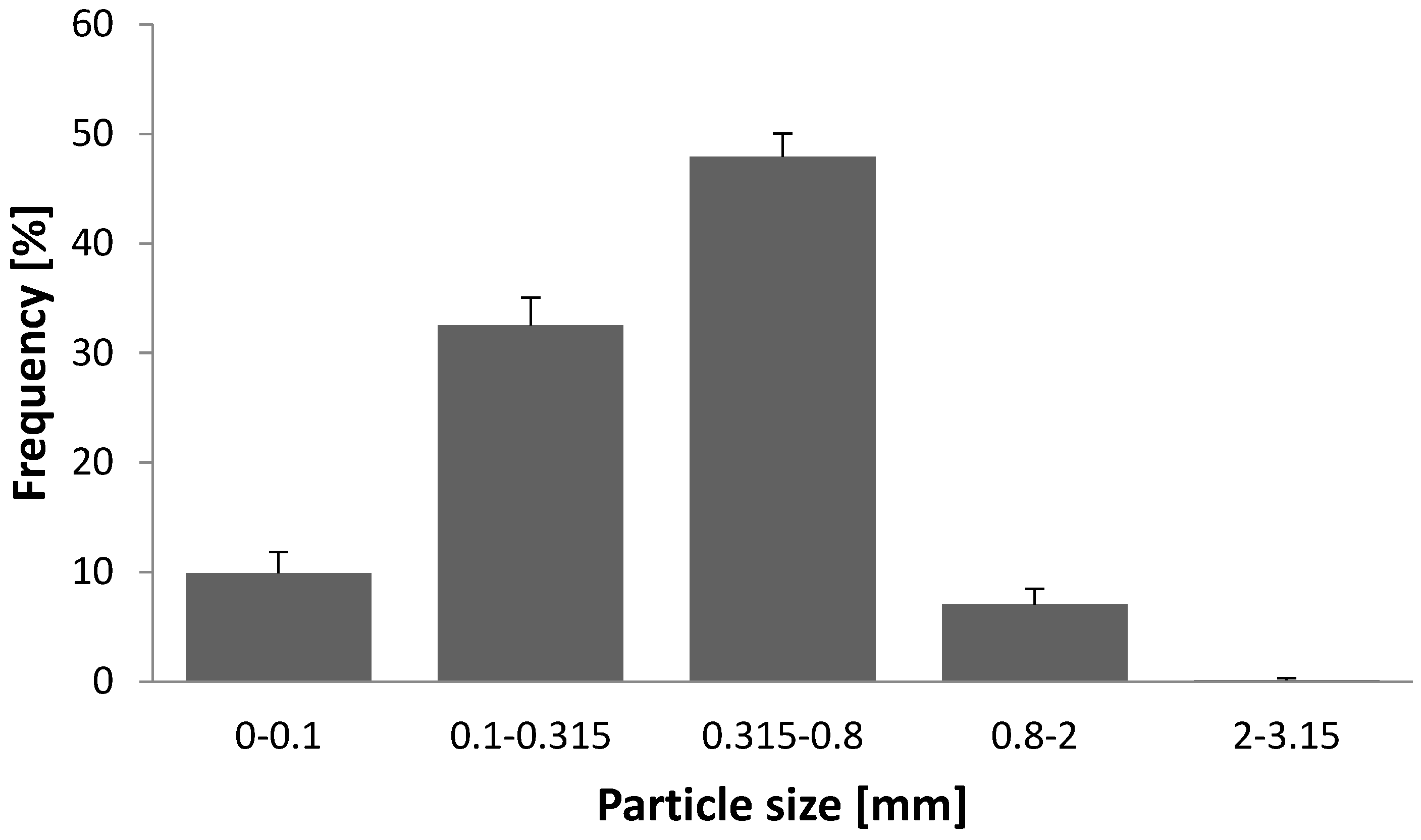
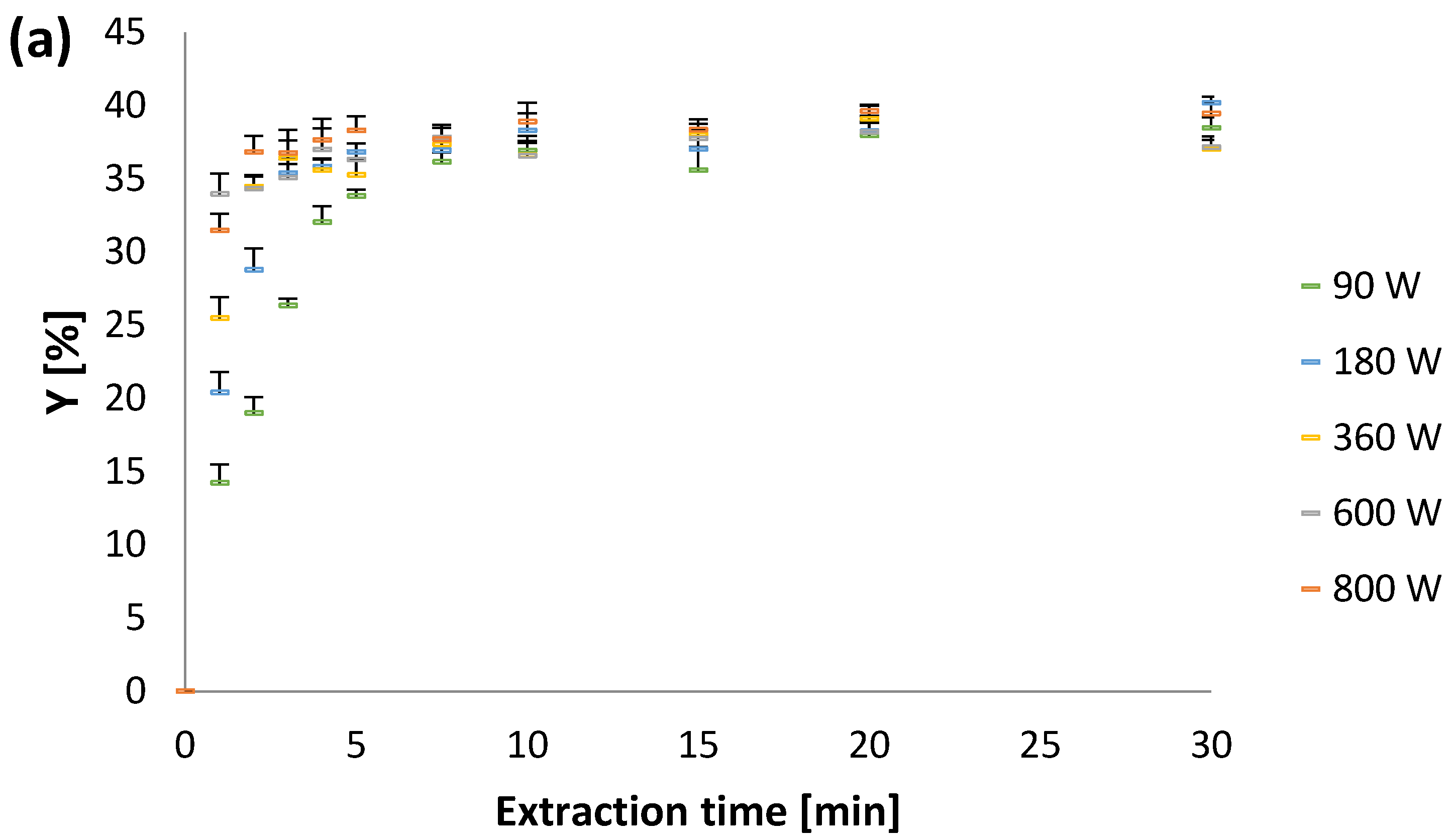
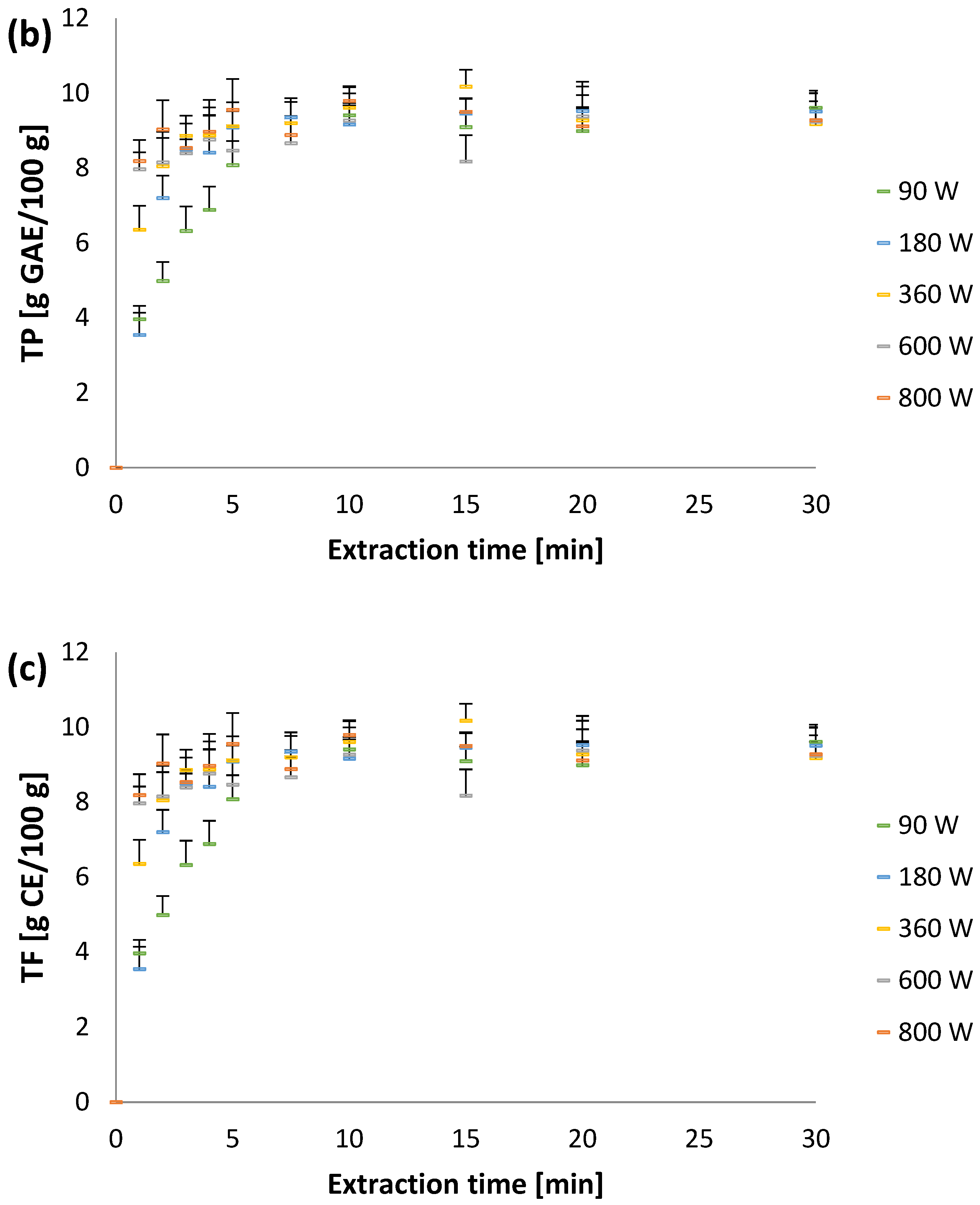
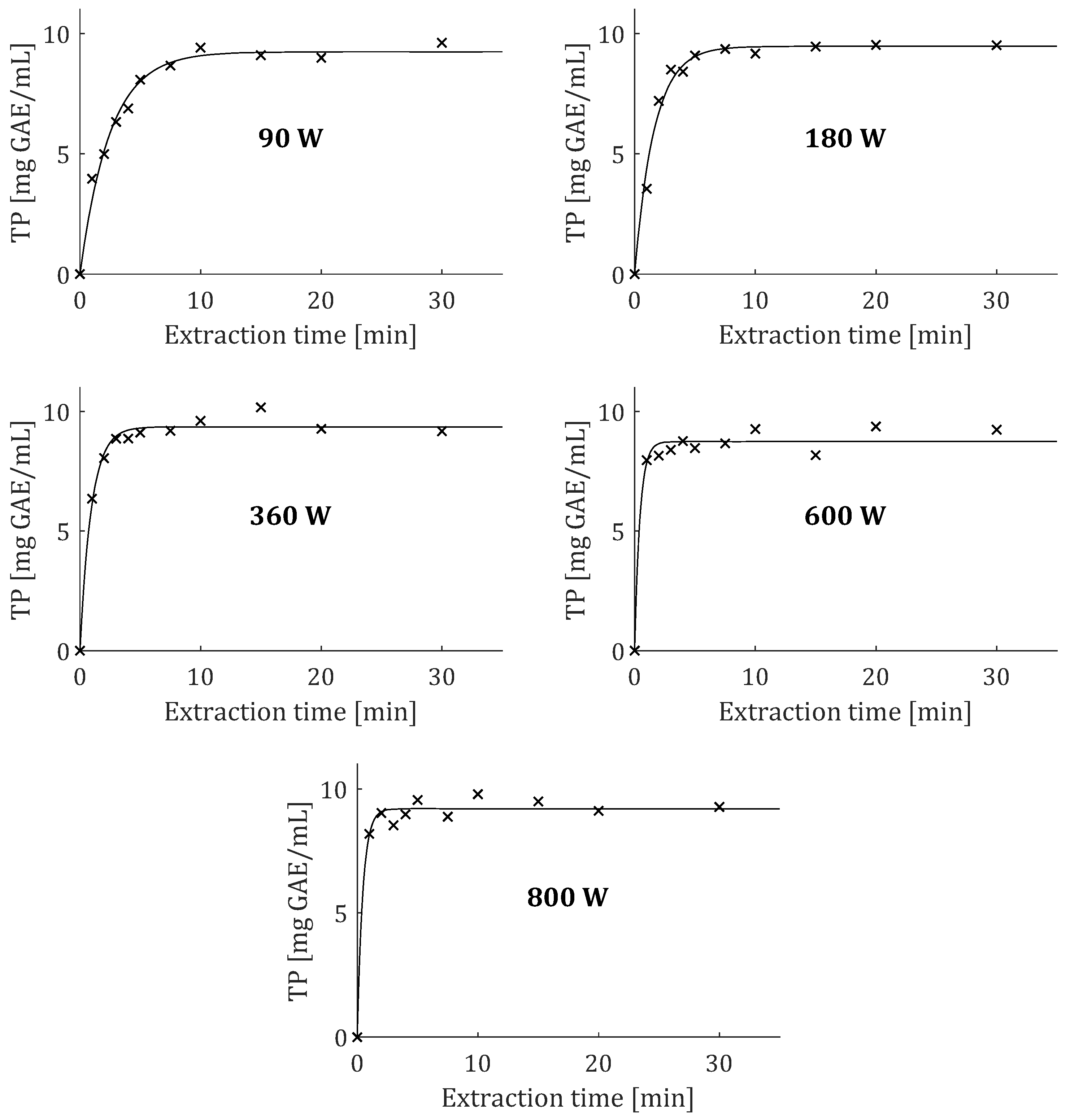
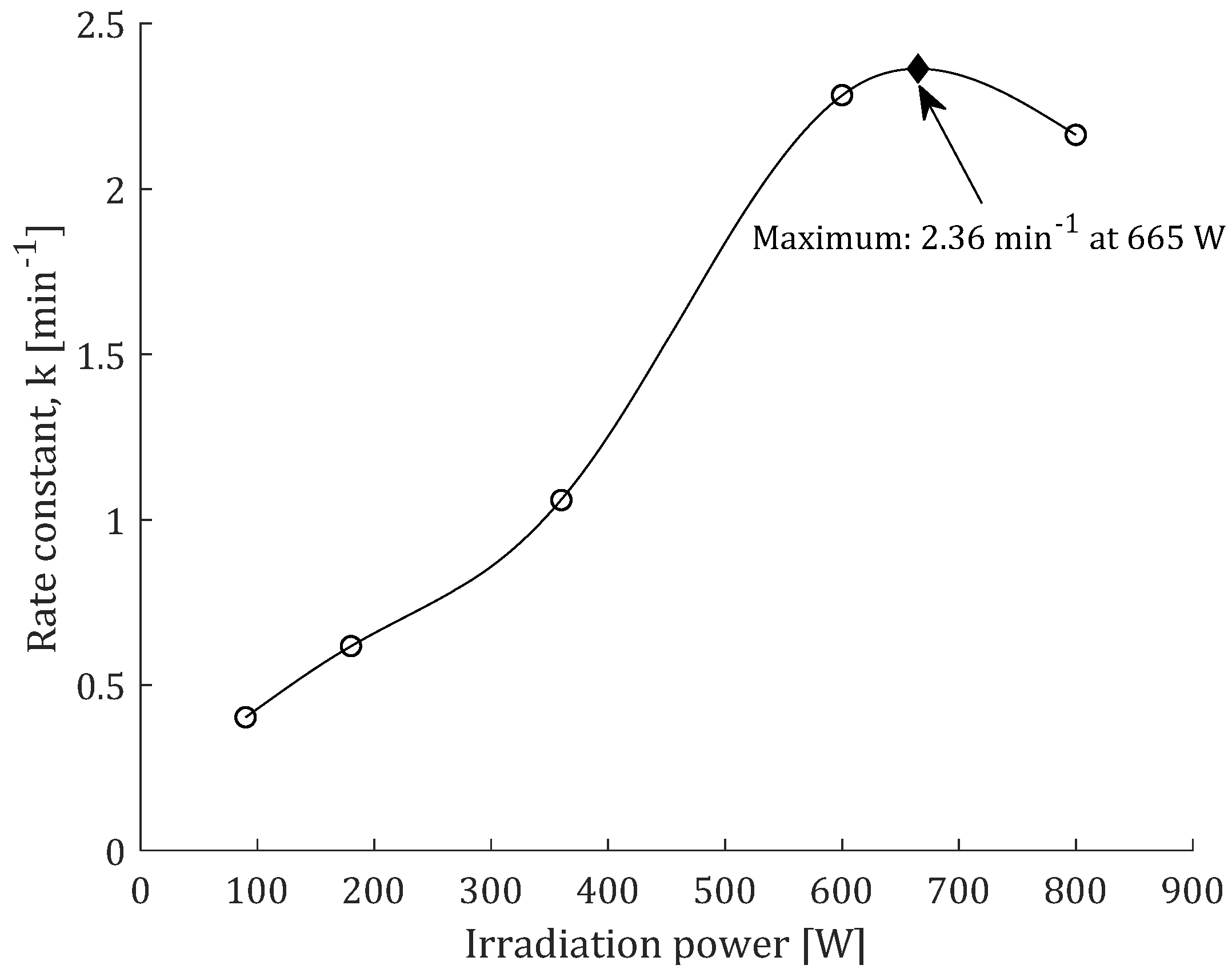
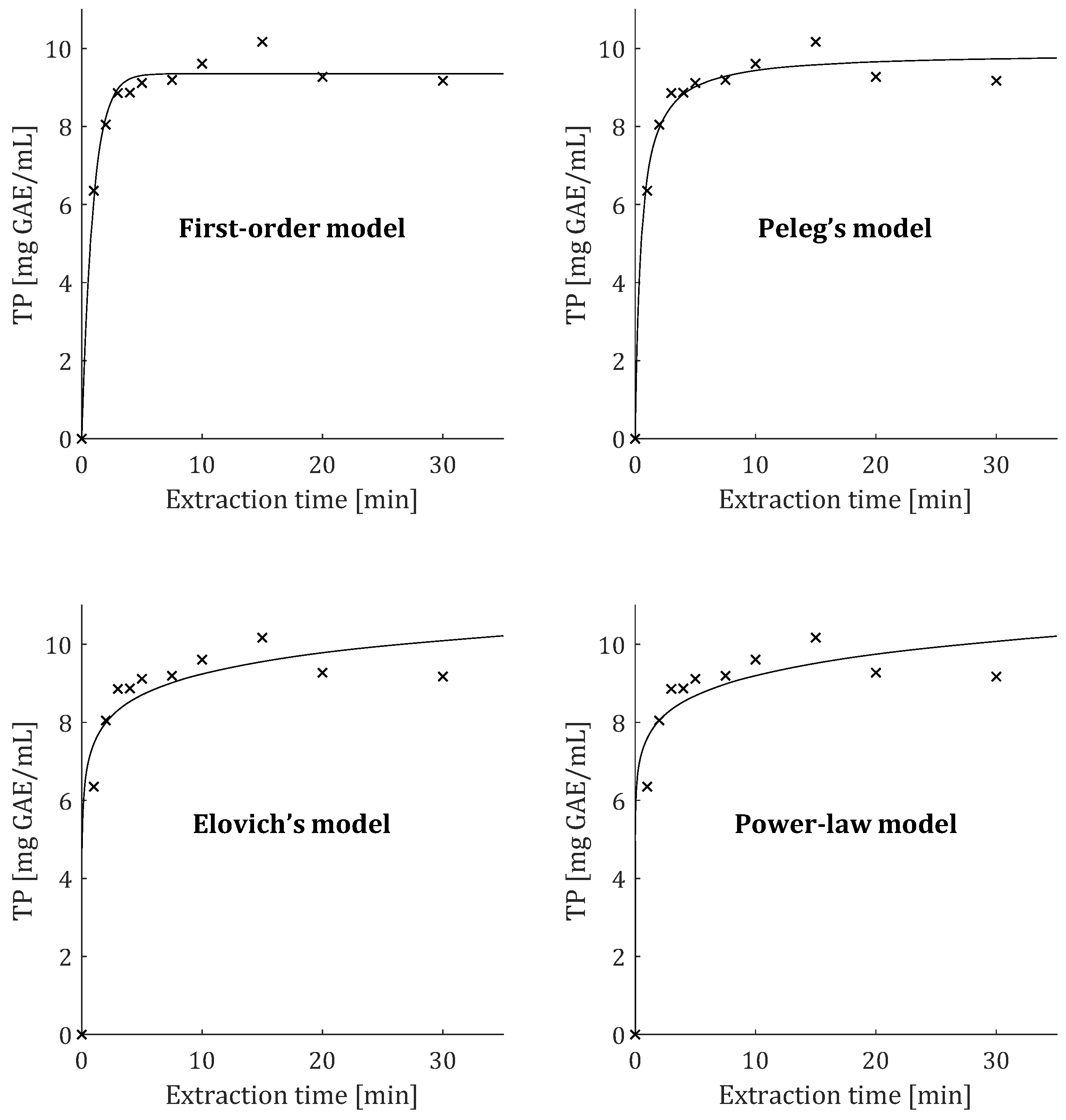
| Model Equation | P [W] | Model Parameters | Statistical Parameters | |||||||
|---|---|---|---|---|---|---|---|---|---|---|
| k | Ceq | E | a | B | n | R2 | SSer | AARD [%] | ||
| 90 | 0.419 | 37.593 | 0.990 | 15.182 | 4.04 | |||||
| 180 | 0.750 | 38.122 | 0.993 | 9.329 | 2.19 | |||||
| 360 | 1.187 | 37.152 | 0.992 | 10.466 | 2.27 | |||||
| 600 | 2.431 | 36.755 | 0.990 | 12.237 | 2.50 | |||||
| 800 | 1.680 | 38.363 | 0.996 | 5.862 | 1.61 | |||||
| Mean | 0.992 | 10.615 | 2.52 | |||||||
| 90 | 1.747 | 42.109 | 0.974 | 39.715 | 6.33 | |||||
| 180 | 0.800 | 41.107 | 0.982 | 24.954 | 4.06 | |||||
| 360 | 0.415 | 39.088 | 0.986 | 17.957 | 3.26 | |||||
| 600 | 0.134 | 37.657 | 0.996 | 4.873 | 1.83 | |||||
| 800 | 0.233 | 39.685 | 0.997 | 3.623 | 1.27 | |||||
| Mean | 0.987 | 18.224 | 3.35 | |||||||
| 90 | 7.225 | 17.882 | 0.835 | 105.918 | 11.05 | |||||
| 180 | 4.701 | 26.218 | 0.730 | 84.126 | 8.14 | |||||
| 360 | 2.773 | 30.470 | 0.616 | 49.360 | 5.08 | |||||
| 600 | 1.204 | 34.209 | 0.740 | 5.225 | 1.68 | |||||
| 800 | 1.855 | 34.109 | 0.722 | 13.591 | 2.60 | |||||
| Mean | 0.729 | 51.644 | 5.71 | |||||||
| 90 | 20.636 | 0.213 | 0.897 | 156.243 | 13.75 | |||||
| 180 | 27.416 | 0.126 | 0.929 | 100.420 | 8.92 | |||||
| 360 | 30.928 | 0.075 | 0.958 | 53.332 | 5.26 | |||||
| 600 | 34.273 | 0.033 | 0.996 | 5.392 | 1.72 | |||||
| 800 | 34.282 | 0.048 | 0.989 | 14.458 | 2.63 | |||||
| Mean | 0.954 | 65.969 | 6.46 | |||||||
| Model Equation | P [W] | Model Parameters | Statistical Parameters | |||||||
|---|---|---|---|---|---|---|---|---|---|---|
| k | Ceq | E | a | B | n | R2 | SSer | AARD [%] | ||
| 90 | 0.403 | 9.236 | 0.984 | 1.461 | 4.90 | |||||
| 180 | 0.618 | 9.466 | 0.986 | 1.327 | 4.40 | |||||
| 360 | 1.060 | 9.356 | 0.987 | 4.959 | 2.86 | |||||
| 600 | 2.284 | 8.744 | 0.976 | 1.706 | 4.08 | |||||
| 800 | 2.164 | 9.202 | 0.985 | 1.161 | 2.95 | |||||
| Mean | 0.984 | 2.123 | 3.84 | |||||||
| 90 | 1.764 | 10.307 | 0.984 | 1.395 | 4.67 | |||||
| 180 | 1.072 | 10.357 | 0.959 | 3.950 | 8.25 | |||||
| 360 | 0.484 | 9.892 | 0.987 | 5.112 | 3.03 | |||||
| 600 | 0.156 | 8.991 | 0.983 | 1.180 | 3.38 | |||||
| 800 | 0.149 | 9.430 | 0.988 | 0.919 | 2.86 | |||||
| Mean | 0.980 | 2.511 | 4.44 | |||||||
| 90 | 1.743 | 4.425 | 0.891 | 3.811 | 7.03 | |||||
| 180 | 1.415 | 5.797 | 0.672 | 10.033 | 12.94 | |||||
| 360 | 0.778 | 7.452 | 0.643 | 23.178 | 6.00 | |||||
| 600 | 0.354 | 8.000 | 0.560 | 1.016 | 2.47 | |||||
| 800 | 0.297 | 8.542 | 0.433 | 1.190 | 3.39 | |||||
| Mean | 0.640 | 7.846 | 6.37 | |||||||
| 90 | 5.028 | 0.215 | 0.931 | 6.039 | 9.73 | |||||
| 180 | 6.276 | 0.153 | 0.871 | 12.194 | 13.92 | |||||
| 360 | 7.600 | 0.083 | 0.953 | 98.974 | 6.22 | |||||
| 600 | 8.017 | 0.041 | 0.985 | 1.019 | 2.48 | |||||
| 800 | 8.562 | 0.032 | 0.984 | 1.208 | 3.42 | |||||
| Mean | 0.945 | 23.887 | 7.15 | |||||||
Disclaimer/Publisher’s Note: The statements, opinions and data contained in all publications are solely those of the individual author(s) and contributor(s) and not of MDPI and/or the editor(s). MDPI and/or the editor(s) disclaim responsibility for any injury to people or property resulting from any ideas, methods, instructions or products referred to in the content. |
© 2023 by the authors. Licensee MDPI, Basel, Switzerland. This article is an open access article distributed under the terms and conditions of the Creative Commons Attribution (CC BY) license (https://creativecommons.org/licenses/by/4.0/).
Share and Cite
Pavlić, B.; Kaplan, M.; Zeković, Z.; Canli, O.; Jovičić, N.; Bursać Kovačević, D.; Bebek Markovinović, A.; Putnik, P.; Bera, O. Kinetics of Microwave-Assisted Extraction Process Applied on Recovery of Peppermint Polyphenols: Experiments and Modeling. Plants 2023, 12, 1391. https://doi.org/10.3390/plants12061391
Pavlić B, Kaplan M, Zeković Z, Canli O, Jovičić N, Bursać Kovačević D, Bebek Markovinović A, Putnik P, Bera O. Kinetics of Microwave-Assisted Extraction Process Applied on Recovery of Peppermint Polyphenols: Experiments and Modeling. Plants. 2023; 12(6):1391. https://doi.org/10.3390/plants12061391
Chicago/Turabian StylePavlić, Branimir, Muammer Kaplan, Zoran Zeković, Oltan Canli, Nebojša Jovičić, Danijela Bursać Kovačević, Anica Bebek Markovinović, Predrag Putnik, and Oskar Bera. 2023. "Kinetics of Microwave-Assisted Extraction Process Applied on Recovery of Peppermint Polyphenols: Experiments and Modeling" Plants 12, no. 6: 1391. https://doi.org/10.3390/plants12061391
APA StylePavlić, B., Kaplan, M., Zeković, Z., Canli, O., Jovičić, N., Bursać Kovačević, D., Bebek Markovinović, A., Putnik, P., & Bera, O. (2023). Kinetics of Microwave-Assisted Extraction Process Applied on Recovery of Peppermint Polyphenols: Experiments and Modeling. Plants, 12(6), 1391. https://doi.org/10.3390/plants12061391










